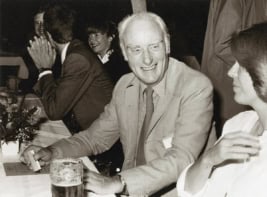How do you get students turned on to physics? Lawrence Krauss believes that using science fiction to teach physics can help to inspire those who might otherwise be uninterested
We’ve all had the following experience. You meet someone at a party, and they ask you what you do. You tell them you are a physicist. Quickly, they change the topic. But if you ask them if they are interested in black holes, warp drives or time travel, then they are fascinated.
Most people think that they have little interest in physics, and yet at the same time they are remarkably interested in many of the things that physics deals with. This dichotomy suggests that we have done a poor job of relating physics to the non-physicist and that the natural way to get people motivated to learn about our field would be to stress the connection between physics and their own interests.
I sometimes have the opportunity to lecture to teachers about teaching and, when I do so, I usually point out that the biggest mistake any teacher can make is to assume that the students are interested in what you have to say. Instead, you have to be prepared to convince them to be interested, and you cannot expect them to come to you. Rather, you must reach out to where they are. I think that this maxim applies far more broadly than just to classroom teaching, but at any rate it certainly applies to public education. Motivation is far more important than clarity, initially at least.
This is all to preface why I – someone who likes to think of himself as a reasonably respectable physicist – found myself writing and lecturing on the physics of Star Trek. After all, Star Trek, as I have to remind many individuals dressed in uniform at my lectures, is science fiction. The show makes no pretence to describe reality, nor to need it. As Gene Rodenberry, the show’s creator, said, the Starship Enterprise is primarily a vehicle for drama. The science is thrown in and arbitrarily bent to fit the needs of the plot – not vice versa.
Nevertheless, Star Trek has captured the public’s imagination. For example, when the Air and Space Museum in Washington DC had an exhibit of the Enterprise, it was the most popular exhibit in the entire history of the museum – far more popular than any real spacecraft that had actually travelled in outer space!
What better way could there be, it seemed to me, to try and reach people than to use an icon of popular culture? As I pondered the issue, I recognized that the series touches on a range of diverse physical phenomena in one way or another. Moreover, I decided that one of the reasons why the series has been so popular with the viewing public over the past 30 years is that it is about possibilities. Surely this is why most physicists do physics? After all, they simply want to know what is possible in the universe. Thus the idea of using the Star Trek setting as a laboratory in which to explore the physics of the real universe began to become more and more natural in my mind.
Ground rules
This is not to say that I did not have misgivings about the whole effort. Since it goes without saying that much of science fiction – and indeed a great deal of Star Trek – involves scientific nonsense, does it diminish the real world of physics to delve into such fantasy worlds? Moreover, what is the point of debunking a fictional universe? And indeed, how would my colleagues view the effort, and how would the fans of Star Trek react to what I was doing?
I decided early on that there had to be several ground rules if this effort were not to revert either into an apologia for the indiscretions of Star Trek writers, or into a nit-picking diatribe that would be of interest to no-one. First, no matter how much it hurt, if something was impossible, I would say so. Second, rather than dwell on these impossibilities, if something in the fiction were impossible, I would find something in the real world to relate it to that might not be.
This whole enterprise has reinforced my conviction that truth is indeed stranger than fiction, and I think that people are most taken by this when examples are thrust in their faces. Indeed, in one of my favourite reviews of my most recent book, Beyond Star Trek , which appeared in the US magazine Publisher’s Weekly , the reviewer – much to his surprise apparently – acknowledged that scientific phenomena are often far more fascinating than fictional ones. I find no better justification for using science fiction as a way to teach science than this demonstration that it can convince people that the real world is fascinating.
I have yet to talk to an audience of laypeople about, say, solar neutrino detection in the context of Star Trek bloopers about neutrinos, without hearing titters erupt when I make the claim that all you have to do to detect solar neutrons is detect several argon atoms in 100 000 gallons of cleaning fluid! It is great fun to then point out that this experiment has been done, and moreover that no science fiction writer in his or her right mind would introduce such a notion in a screenplay because it seems so implausible. And without the Star Trek hook, I am not sure I would even have had an audience in the lecture theatre to have this kind of “ah ha” experience, as they say in science museums.
Science fiction into the classroom
But can this approach work beyond the world of popular books and lectures, and in the classroom? I believe it can. Since writing my books, I have heard from countless high-school teachers that they have used Star Trek or other examples from science fiction for some time as a way to both motivate otherwise uninterested students and to further excite those students who are already turned on by physics. Having books that touch on the most modern developments in physics in this context helps teachers by giving them access to examples of which they would probably otherwise not have been aware.
Nevertheless, I have found that realizing that something very basic can be understood in a new way is often far more powerful than the satisfaction gained from obtaining new perspectives on the various exotica of modern physics. We all try to make the questions in our problem sets more exciting than the “Joe and Jane were travelling down the road at 50 miles per hour…” type that many of us were exposed to in introductory physics courses. Why not then get students to show that Jean-Luc Picard, captain of the Enterprise in Star Trek: The Next Generation , would be squashed like an ant by g-forces every time he uttered “Engage!”, or that the alien invaders in the movie Independence Day would wreak havoc merely by bringing a spacecraft with a quarter of the mass of the Moon into a geostationary orbit around the Earth? It is for precisely these reasons, in fact, that I began my last two books with these two examples.
Indeed, there is a school of thought in physics education that suggests that the only way to really have students learn things and remember them afterwards is to make them directly confront their own incorrect preconceptions about physics. Get them, for example, to first explain why objects of different mass fall at different rates, and then show them that this isn’t so. A generation reared on Star Trek – and more recently The X Files and movies such as Star Wars and Independence Day – is primed with misconceptions just waiting to be exploited!
Dangers and pitfalls
This approach is, of course, not without its pitfalls. I have found that the most egregious public misconception about science is the feeling that scientific revolutions do away with all that came before them. The public thinks that nothing is impossible and that everything that we think is true today will one day be proved wrong. (So, the logic goes, why bother paying attention to physics at all?) This, needless to say, is completely antithetical to the central features of science – namely that we can only prove things to be false (not true) and that principles that violate experimental test now will continue to violate them in the future. (I wish I could convey these ideas more effectively to some of my Post-modernist colleagues in the humanities!)
You have to be careful when having fun with the universes of science fiction to make sure that your audience does not come away confused about these central themes. Indeed, I receive more letters about ideas that I claim are impossible than anything else. (Most of the letters are prefaced by something like: “They would have said you were crazy if you talked about aeroplanes in the 16th century…”.) Our responsibility is to teach people how to separate the difference between areas where we simply do not know the answers – where indeed, anything, or almost anything, may be possible – from those areas where we have a clear notion of which ideas are incorrect.
While I recognize that resorting to the world of science fiction can sometimes blur this distinction, I think that, if one is careful, the advantages of reaching out to popular culture do, in the end, far outweigh the possible dangers.



